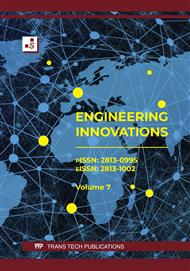[1]
Y.Y. Ju, L. Zhang, Molecular Dynamics Simulation of Shock Wave Propagation in Aluminum Single Crystal, Journal of Metastable and Nanocrystalline Materials 36 (2023) 1-6.
DOI: 10.4028/p-18w2oa
Google Scholar
[2]
I.A. Bryukhanov, Atomistic simulation of the shock wave in copper single crystals with pre-existing dislocation network, International Journal of Plasticity 151 (2022) 103171.
DOI: 10.1016/j.ijplas.2021.103171
Google Scholar
[3]
Y. Chen, Z.Y. Jian, S.F Xiao, L. Wang, X.F. Li, K. Wang, H.Q. Deng and W.Y. Hu, Molecular dynamics simulation of shock wave propagation and spall failure in single crystal copper under cylindrical impact, Appl. Phys. Express 14 (2021) 075504.
DOI: 10.35848/1882-0786/ac06de
Google Scholar
[4]
Y.T. Wang, X.G. Zeng, X. Yang, T.L. Xu, Shock-induced spallation in single-crystalline tantalum at elevated temperatures through molecular dynamics modeling, Computational Materials Science 201 (2022) 110870.
DOI: 10.1016/j.commatsci.2021.110870
Google Scholar
[5]
J.A. Zimmerman, J.M. Winey, and Y.M. Gupta, Elastic anisotropy of shocked aluminum single crystals: Use of molecular dynamics simulations, Phys. Rev. B, 83 (2011) 184113.
DOI: 10.1103/physrevb.83.184113
Google Scholar
[6]
Q. An, R. Ravelo, T.C. Germann, W.Z. Han, S.N. Luo, D.L. Tonks, and W.A. Goddard, Shock compression and spallation of single crystal tantalum, AIP Conf. Proc., 1426 (2012) 1259-1262.
Google Scholar
[7]
Y.Y. Ju, Q.M. Zhang, Z.Z. Gong, G.F. Ji, and L. Zhou. Molecular dynamics simulation of shock melting of aluminum single crystal, J. Appl. Phys., 114 (2013) 093507.
DOI: 10.1063/1.4819298
Google Scholar
[8]
A. Neogi, N. Mitra, A metastable phase of shocked bulk single crystal copper: an atomistic simulation study, Sci. Rep. 7, (2017) 7337.
DOI: 10.1038/s41598-017-07809-1
Google Scholar
[9]
A. Neogi, N. Mitra, Evolution of dislocation mechanisms in single-crystal Cu under shock loading in different directions, Modelling and Simulation in Materials Science and Engineering, 25 (2017) 025013.
DOI: 10.1088/1361-651x/aa5850
Google Scholar
[10]
A. Neogi, N. Mitra, Shock induced deformation response of single crystal copper: Effect of crystallographic orientation, Computational Materials Science, 135 (2017) 141-151.
DOI: 10.1016/j.commatsci.2017.04.009
Google Scholar
[11]
A. Neogi; L. He; N. Abdolrahim, Atomistic simulations of shock compression of single crystal and core-shell Cu@Ni nanoporous metals, J. Appl. Phys. 126 (2019) 015901.
DOI: 10.1063/1.5100261
Google Scholar
[12]
A. Bisht, A. Neogi, N. Mitra, G. Jagadeesh, S. Suwas, Investigation of the elastically shock-compressed region and elastic–plastic shock transition in single-crystalline copper to understand the dislocation nucleation mechanism under shock compression. Shock Waves 29 (2019) 913-927.
DOI: 10.1007/s00193-018-00887-8
Google Scholar
[13]
E.M. Bringa, A. Caro, M. Victoria, and N. Park, The atomistic modeling of wave propagation in nanocrystals, Journal of metals, 57 (2005) 67-70.
DOI: 10.1007/s11837-005-0119-9
Google Scholar
[14]
W. Ma, W.J. Zhu, and F.Q. Jing, The shock-front structure of nanocrystalline aluminum, Appl. Phys. Lett., 97 (2010) 121903.
Google Scholar
[15]
A.P. Gerlich, L. Yue, P.F. Mendez, and H. Zhang, Plastic deformation of nanocrystalline aluminum at high temperatures and strain rate, Acta Materialia, 58 (2010) 2176–2185.
DOI: 10.1016/j.actamat.2009.12.003
Google Scholar
[16]
M.Z. Xiang, H.B. Hu, and J. Chen, Spalling and melting in nanocrystalline Pb under shock loading: Molecular dynamics studies, J. Appl. Phys., 113 (2013) 144312.
DOI: 10.1063/1.4799388
Google Scholar
[17]
J. Mei, J.W. Davenport, and G.W. Fernando, Analytic embedded-atom potentials for fcc metals: Application to liquid and solid copper, Phys. Rev. B, 43 (1991) 4653.
DOI: 10.1103/physrevb.43.4653
Google Scholar
[18]
LAMMPS, Sandia National Laboratories. [online], Available from: http://lammps.sandia.gov.
Google Scholar
[19]
D. Chen, Structural modeling of nanocrystalline materials, Comput. Mater. Sci., 3 (1995) 327-333.
Google Scholar
[20]
S.P. Marsh. LASL Shock Hugoniot Data (University of California Press, Berkeley, 1980).
Google Scholar
[21]
L.V. Al'tshuler, S.B. Kormer, A.A. Bakanova, and R.F. Trunin, The isentropic compressibility of aluminum, copper, lead, and iron at high pressures, Sov. Phys. JETP, 11 (1960) 790.
Google Scholar
[22]
R.F. Trunin, M. Yu. Belyakova, M.V. Zhernokletov, and Y.N. Sutulov, Izv. Akad. Nauk SSSR, Fiz. Zemli, Shock compression of metal alloys, 2 (1991) 99.
Google Scholar
[23]
D.K. Belashchenkoa, A.V. Vorotyagina, and B.R. Gelchinsky, Computer simulation of aluminum in the high-pressure range, High Temperature, 49 (2011) 656.
Google Scholar
[24]
L. Koči, E.M. Bringa, D.S. Ivanov, J. Hawreliak, J. McNaney, A. Higginbotham, L.V. Zhigilei, A.B. Belonoshko, B.A. Remington, and R. Ahuja, Simulation of shock-induced melting of Ni using molecular dynamics coupled to a two-temperature model, Phys. Rev. B, 74 (2006) 012101.
DOI: 10.1103/physrevb.74.012101
Google Scholar
[25]
A. Kubota, D.B. Reisman, and W.G. Wolfer, Dynamic strength of metals in shock deformation, Appl. Phys. Lett., 88 (2006) 241924.
Google Scholar
[26]
J.A. Moriarty, D.A. Young, and M. Ross, Theoretical study of the aluminum melting curve to very high pressure, Phys. Rev. B, 30 (1984) 578.
DOI: 10.1103/physrevb.30.578
Google Scholar
[27]
R.F. Trunin. The properties of condensed matter under high pressure and high temperature Translated by J. W. Han (Institute of Fluid Physics, CAEP, Mianyang, 1996) pp.40-52. (in Chinese)
Google Scholar


